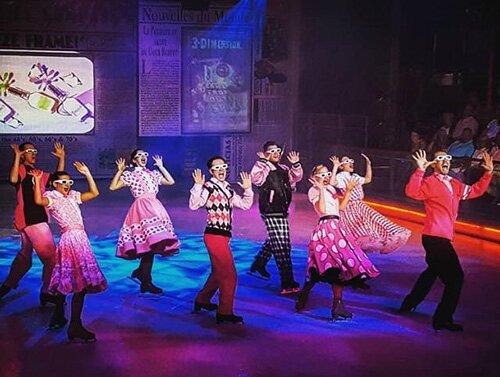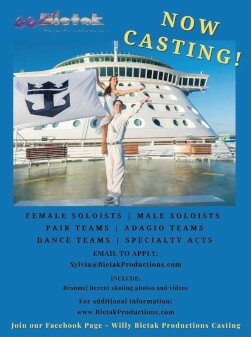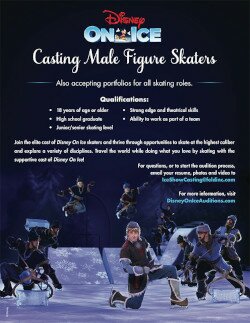

Like to travel but don’t like to pack? Cruising into the world of professional skating and leaving behind a competitive career can be daunting for many athletes, with few options available for those who are not quite ready to move into the business or coaching world and want to continue skating.
With the 2018-2019 season in the books — the final one for a number of skaters — performing on a ship and cruising the world could be just the transition some are looking for.
Willy Bietak Productions, a company based in Santa Monica, California, is the creative force behind the production of the skating shows that form part of the entertainment sector on Royal Caribbean’s 12 mega ships. Cruising the world with all expenses paid has been a dream job for thousands of skaters who have worked with the Bietak team the past two decades. With cruising options that include Oceania, the Far East, the Caribbean, Europe, Scandinavia, Canada and the Mediterranean in the summer, the company offers an array of opportunities for figure skaters transitioning into the professional ranks.
“There are so many opportunities to see the world and go to some amazing places,” said Sylvia Froescher, who has been the associate producer of the Bietak shows for 15 years. She oversees all aspects of the productions, from casting to choreography and costume design. Though cruising the high seas is not for everyone, Froescher said that because skaters have no expenses on board the ship, it is a great opportunity to save money. “A lot of former competitive skaters have gotten out of debt by working on the ships.”
At any one time, there are 15 different Bietak shows taking place on the 12 ocean liners, each with its own theme. “Some of the cruises have two shows, based on the ship’s itinerary,” Froescher explained. “If a ship is running a two-week itinerary, they want to have one show for the first week and a second show for the second week. Each of the shows is completely different.”
Bietak hires skaters from all disciplines: male and female soloists, and pairs and ice dance teams that are also able to do adagio style lifts and elements. “Not everyone will make it onto the podium at competitions, but in a show you get the spotlight, gratification and instant feedback from audiences hundreds of times. It can be life changing,” Froescher said.
“On a couple of the ships we have what is called a freestyle skater — an extreme type of skating that is more acrobatic. Sometimes the person will wear hockey skates, or be in a character driven role, doing things like backflips and handsprings. We also have a sand artist who tells a story by creating art through sand, which is projected onto a big screen.
“In addition to that, we also have our speciality “ice acts” — aerialists who perform in skates, a German wheel act, a quick-change act and a hula hoop act. We intersperse these throughout our 45-minute shows as it breaks it up for the audiences and gives them something a little different than what they have been watching. It is a super popular part of the show.”
Froescher said that as every skater performs a solo, the company looks for skaters who have competed at the national, World or Olympic level. “The guys all do triples and backflips and the ladies need a minimum of a double Axel with some type of triple. Pairs teams do the same lifts and throws as the ones they do in competition. With our ice dance teams, we also look for some lifting and adagio abilities because it is not very easy to helicopter in a replacement skater when we have an injury in the middle of the ocean.
“Obviously, everyone has to have good performance abilities because that is what the job is all about. Skaters do six months on one ship, have a few months off for vacation, and are then cast in a new role on a different ship.
“One of the things I hear from skaters all the time is that the quality of the shows we produce is at the highest level, which challenges them not just technically but also choreographically. Because we have high-level skaters we can push them with the choreography, so they really have to think and use their bodies every time they go out to perform. They feel a great sense of satisfaction at being challenged.
“The onboard ice surfaces are 60 x 40 feet and the way the arenas are set up is similar to a competitive arena, where the audience is around three sides. So skaters are very close to the audience. There are times when they could reach out and touch someone in the audience.”
Aside from performing, skaters work on other shows produced by the ship’s entertainment department, which supports eight different venues, including a theatre that holds 1,500 people where two or three dance shows are held each evening. “The skaters support those shows by running the spotlights and directing them and in return the dancers support the skating shows,” Froescher explained.
“We have three different sizes of ships — Voyager, Freedom and Oasis class. The size of the ship and the itinerary determines the different roles skaters might have outside of their own shows. On some ships, there is a parade similar to what you would see on an evening at Disney World. On the larger ships, there is an indoor mall where they do a themed parade for the guests — maybe one per cruise. All performers in the entertainment division take part in it.
“Then there is public ice skating. Skaters organize that for the guests so they can go onto the ice and learn just how hard it is to skate and get an even greater appreciation for what they are seeing in our shows. The opportunities for crew members and performers to go to other areas are dependent upon the size of the ship. The guests who paid for their cruising vacations come first, but Royal Caribbean likes the performers to meet the passengers and vice versa.
“One of the really lovely parts of this is that those who work on the ships turn into a family. On some ships, there can be 900-1,200 crew members from all over the world. Usually, there are about 60 different nationalities working on a ship, so if we have skaters from Russia or Japan they will connect with others from their homelands and other countries as well. There have been a few marriages come out of this.
“Skaters can leave the ship when it docks to go sightseeing. In countries like Thailand and Malaysia — places people might not normally get to go to — we encourage them to get off the ship and enjoy the experience. When we went to Brisbane, Australia, holding a koala for the first time was one of my bucket list things. It was such a special day.”
Bietak recruits in many ways, one of which is through in-person auditions. “Sometimes, when I am travelling I am able to hold an audition in a city. Or we do auditions with pro skaters at various events a couple of times a year,” Froescher said. “Skaters can also submit photos, résumé and a 2-3 minute video which highlights their skills. It is always nice to see an exhibition number as well as a competitive routine. Rehearsals are held on board the ship. It is a great learning tool for new cast members because they get to see the existing cast performing the show. If we are doing a brand-new production, then we rehearse at our warehouse in Los Angeles.”
The company also produces shows such as “Broadway on Ice” and “Festival on Ice,” and recently produced its first “Opera Festival on Ice” in Oman, Jordan, headlined by 2014 Olympic ice dance champions Meryl Davis and Charlie White. “That show in particular was very challenging,” said Froescher. “It was a new concept that we are looking to book in other opera houses around the world.”
The company is currently casting for contracts that will start in late 2019. If you think cruising could be the right fit for you. For more information, email sylvia@bietakproductions.com or visit bietakprodutions.com.




